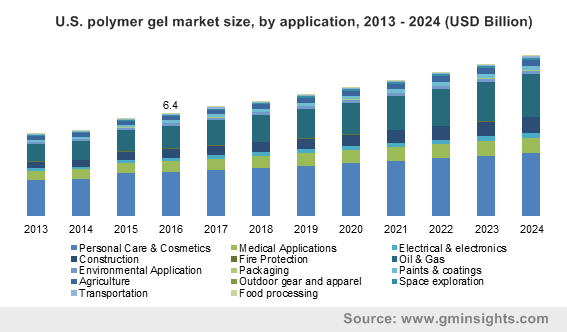Hydrogel-based polymer gel market to accrue exponential gains over 2017-2024, high-grade technological advancements to expedite the application landscape
Publisher : Fractovia | Published Date : 2018-03-05Request Sample
The robust growth of polymer gel market can be appropriately credited to the evolving product deployment across diverse end-use domains ranging from agriculture and healthcare to oil and gas. Polymer gel possesses phenomenal shape-altering properties, robust liquid absorption capacity, features superlative control in slow fluid release, and can move when induced with electric current. Indeed, these exceptional characteristics have helped expand the application spectrum of this product, providing a positive boost to polymer gel market. With the added advantage of extensive research and development programs being conducted not only by industry players but also by the academic community, polymer gel market is expected to continue its phenomenal growth over 2017-2024.
U.S. polymer gel market size, by application, 2013 - 2024 (USD Billion)

The exponential revenue graph of polymer gel market can be essentially credited to the various applications of hydrogels. Indeed, hydrogel-based polymer gel industry is anticipated to register a CAGR of 8.5% over 2017-2024, driven by the self-supporting, 3D viscoelastic network of hydrogels that helps them diffuse molecules and cells. On these grounds, hydrogels find widespread applications in the biomedical industry such as in wound healing, cell therapeutics, bone or cartilage regeneration and sustained release of drugs, thus propelling polymer gel market share.
Polymer gel industry trends from the medical space
The use of hydrogels for the production of soft contact lenses has indeed revolutionized contact lens industry, consequently contributing toward a substantial portion of polymer gel market revenue. Soft contact lenses won the market over from hard contact lenses as they are easier to adapt to and have excellent biocompatibility, water permeability, oxygen permeability, mechanical strength, sufficient refractive index and stability. Having emerged as the material of choice for the contact lens industry, hydrogels are being manipulated to produce superior quality lens. Thus, the enhanced application of polymer hydrogels for contact lens manufacturing will massively impel polymer gel market share.
Polymer gel industry has also paved its way toward success through the application of hydrogels as an ideal wound dressing material. Hydrogels proved to be extremely beneficial when it comes to chronic wound management, as hydrogel wound dressings help monitor the fluid exchange within the surface of the wound, thus keeping it sufficiently hydrated while protecting it from external infections. Hydrogel dressings need to be changed less often, proving to be highly beneficial for medical practitioners.
The advancements in drug delivery through hydrogel technology are becoming increasingly popular lately, as drugs loaded into hydrogels can be released in a chemically and environmentally controlled manner which can last for days, weeks or even months. With drug delivery through hydrogels becoming a highly commercialized process, polymer gel industry has found another profitable growth ground for revenue generation.
Polymer gel industry to gain momentum from domestic uses of hydrogels and SAPs
Apart from medical uses, hydrogels are extensively used for domestic applications. Subject to their remarkable absorbent properties, hydrogels have come to be widely used in diapers. The deployment of diapers with water retention qualities has indeed, cut down on dermatological issues related to prolonged exposure of tissue to wet surface. This in consequence, has benefitted not only the diaper manufacturing industry, but has also provided a considerable stimulus to polymer gel industry size.
The slow water releasing feature of hydrogels has proven to be beneficial for polymer gel market, as hydrogels have come to be increasingly employed as water reservoirs for gardening and industrial horticulture. Though the environmental impact of super absorbent polymers (SAP) has been questioned by the scientific community, the advantages of using SAPs have won popularity for the product which has come to be widely used in agriculture, municipal gardening, forestry, drought management and water conservation.
The application landscape of polymer gel market is indeed vastly diverse. Polymer gels are popularly used in tissue engineering, plastic surgery, cosmetics, perfume delivery, immunotherapy, water treatment, bacterial culture, cardiac applications, dental applications and electronic applications. Apart from hydrogels, aerogels, which is predicted to be the fastest growing segment of the polymer gel market in the 2017-2024 period, has also strengthened the position of this business space through its application in oil and gas industry. The O&G segment accounted for over 60% of the aerogel polymer gel market in 2016. Aerogels are used in subsea insulation system, LNG terminals, vertical piping, and deep-water pipe-in-pipe tieback installation as well. The oil and gas sector has also propelled hydrogel polymer gel market as hydrogels are widely used in the prevention of fluid loss and spill prevention.
Driven by extensive research & development programs, polymer gel industry is forecast to gain heavy returns by 2024. Numerous companies have also been working effortlessly to unleash the full potential of polymer gels. Subsequently, aided by massive technological developments and a mammoth application spectrum, polymer gel market is certain to emerge as a highly remunerative business sphere over 2017-2024.